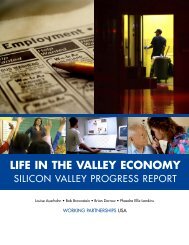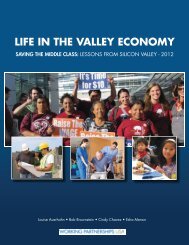Life in the Valley Economy 2010 - Working Partnerships USA
Life in the Valley Economy 2010 - Working Partnerships USA
Life in the Valley Economy 2010 - Working Partnerships USA
You also want an ePaper? Increase the reach of your titles
YUMPU automatically turns print PDFs into web optimized ePapers that Google loves.
jobs are hard to f<strong>in</strong>d. As of spr<strong>in</strong>g <strong>2010</strong>, 40% of middle class Americans reported that <strong>the</strong>y were struggl<strong>in</strong>g to<br />
rema<strong>in</strong> <strong>in</strong> <strong>the</strong> middle class. 14<br />
Middle class f<strong>in</strong>ancial and asset <strong>in</strong>stability have been brought to <strong>the</strong> forefront of national attention with<br />
<strong>the</strong> advent of <strong>the</strong> hous<strong>in</strong>g and foreclosure crisis. Homeownership is a hallmark of <strong>the</strong> American Dream, and<br />
own<strong>in</strong>g one’s own home has long been viewed as key to ensur<strong>in</strong>g family stability and f<strong>in</strong>ancial security. But<br />
<strong>in</strong> <strong>the</strong> past two years, millions of American families have seen that dream disappear as <strong>the</strong>ir homes have been<br />
lost to foreclosure.<br />
American households’ total net worth decl<strong>in</strong>ed by 16% <strong>in</strong> 2008 and 21% <strong>in</strong> 2009. 15 This decl<strong>in</strong>e <strong>in</strong> household<br />
wealth not only <strong>in</strong>creases <strong>in</strong>security for <strong>in</strong>dividuals and families, but threatens to curtail economic growth:<br />
lack<strong>in</strong>g assets, households have less capacity to spend or <strong>in</strong>vest.<br />
KEY FINDINGS<br />
• Hous<strong>in</strong>g Market: In <strong>the</strong> past two and a half years, <strong>the</strong> median value of homes <strong>in</strong> <strong>the</strong> San Jose<br />
metro area has fallen by 24.2%. Moderately priced homes were <strong>the</strong> hardest hit; homeowners <strong>in</strong><br />
<strong>the</strong> lowest-priced hous<strong>in</strong>g tier have, on average, lost all of <strong>the</strong>ir home’s appreciation s<strong>in</strong>ce 2000.<br />
• Foreclosures: Foreclosures <strong>in</strong> Santa Clara County have broken records every year for <strong>the</strong> past four<br />
years, with 15,118 notices of default filed <strong>in</strong> 2009, an <strong>in</strong>crease of 481% compared to 2006.<br />
• Bankruptcies: Personal bankruptcies <strong>in</strong> Nor<strong>the</strong>rn California were at an all-time high <strong>in</strong> 2009,<br />
up 160% s<strong>in</strong>ce 2007.<br />
• Unemployment: Long-term unemployment <strong>in</strong> California has more than doubled s<strong>in</strong>ce 2007; <strong>in</strong> 2009,<br />
an unprecedented 35% of all unemployed workers were out of work for more than six months.<br />
• Underemployment: A total of 228,122 people—one out of every five Silicon <strong>Valley</strong> workers—were<br />
underemployed <strong>in</strong> 2009, an 89% <strong>in</strong>crease s<strong>in</strong>ce 2007.<br />
• Labor Force Utilization: A smaller percentage of Californians were work<strong>in</strong>g <strong>in</strong> 2009 than at any<br />
time s<strong>in</strong>ce 1977.<br />
• Public Cost of Low-Wage Work: In Santa Clara County, a worker with two children who earns<br />
$10/hour is eligible for public assistance worth $15,572 annually due to <strong>in</strong>adequate <strong>in</strong>come,<br />
despite hav<strong>in</strong>g a full-time job.<br />
• Labor Unions: California workers who are represented by a union are 50% more likely to have<br />
employer-provided health <strong>in</strong>surance and 96% more likely to have a retirement plan than nonunion<br />
workers, but total union membership decl<strong>in</strong>ed <strong>in</strong> 2009.<br />
• Public Assistance: As of January <strong>2010</strong>, more than one out of every seven Santa Clara County<br />
residents receives some form of public assistance. Dur<strong>in</strong>g <strong>the</strong> recession <strong>the</strong> number of people<br />
receiv<strong>in</strong>g food stamps has jumped 53%.<br />
Chapter 3: Stay<strong>in</strong>g Healthy<br />
Trends <strong>in</strong> children’s health coverage have been encourag<strong>in</strong>g <strong>in</strong> recent years for Santa Clara County, as local<br />
policy has helped expand access to quality public health <strong>in</strong>surance programs. However, fund<strong>in</strong>g limitations at <strong>the</strong><br />
federal, state, and local level cont<strong>in</strong>ue to threaten <strong>the</strong> ongo<strong>in</strong>g susta<strong>in</strong>ability of <strong>the</strong>se programs, especially <strong>in</strong> light<br />
of <strong>the</strong> economic difficulties <strong>in</strong> <strong>the</strong> last two years which have greatly <strong>in</strong>creased <strong>the</strong> demand for publicly supported<br />
children’s health coverage. Recently passed comprehensive national health reform will provide some additional<br />
fund<strong>in</strong>g for children’s health programs, but if California enacts <strong>the</strong> Governor’s proposed cuts to children’s health<br />
coverage, it will lose access to this fund<strong>in</strong>g.<br />
Although <strong>the</strong> most recent data on adult health <strong>in</strong>surance <strong>in</strong> Santa Clara County show overall rates hold<strong>in</strong>g<br />
steady, decl<strong>in</strong><strong>in</strong>g trends <strong>in</strong> employer sponsored coverage are cause for alarm. Nationally, <strong>the</strong> rise <strong>in</strong> health care<br />
costs and <strong>in</strong>surance premiums <strong>in</strong> recent years has caused employers to shift more costs to employees or drop<br />
coverage altoge<strong>the</strong>r. More people have become un<strong>in</strong>sured and face obstacles to obta<strong>in</strong><strong>in</strong>g coverage <strong>in</strong> <strong>the</strong> private<br />
market due to prohibitive costs or pre-exist<strong>in</strong>g conditions.<br />
The recently passed national health care reform package will beg<strong>in</strong> to address <strong>the</strong>se issues by expand<strong>in</strong>g Medi-<br />
Cal, requir<strong>in</strong>g <strong>in</strong>dividuals to hold health <strong>in</strong>surance, and offer<strong>in</strong>g subsidies to make it affordable. However, most of<br />
<strong>the</strong>se provisions do not take effect until 2014, mak<strong>in</strong>g it critical that Santa Clara County ma<strong>in</strong>ta<strong>in</strong> its health care<br />
safety net to “bridge <strong>the</strong> gap” of <strong>the</strong> next four years. Beyond health <strong>in</strong>surance, fur<strong>the</strong>r steps are needed to make<br />
health care services accessible to all, and to address broader community health issues such as childhood obesity.<br />
Page 8<br />
Work<strong>in</strong>g <strong>Partnerships</strong> <strong>USA</strong>




